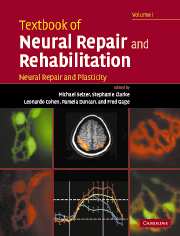Book contents
- Frontmatter
- Contents
- Contents (contents of Volume II)
- Preface
- Contributors (contributors of Volume I)
- Contributors (contributors of Volume II)
- Neural repair and rehabilitation: an introduction
- Section A Neural plasticity
- Section A1 Cellular and molecular mechanisms of neural plasticity
- Section A2 Functional plasticity in CNS system
- Section A3 Plasticity after injury to the CNS
- Section B1 Neural repair
- 16 Neuronal death and rescue: neurotrophic factors and anti-apoptotic mechanisms
- 17 Axon degeneration and rescue
- 18 Adult neurogenesis and neural precursors, progenitors, and stem cells in the adult CNS
- 19 Axon guidance during development and regeneration
- 20 Synaptogenesis
- Section B2 Determinants of regeneration in the injured nervous system
- Section B3 Promotion of regeneration in the injured nervous system
- Section B4 Translational research: application to human neural injury
- Index
20 - Synaptogenesis
from Section B1 - Neural repair
Published online by Cambridge University Press: 05 March 2012
- Frontmatter
- Contents
- Contents (contents of Volume II)
- Preface
- Contributors (contributors of Volume I)
- Contributors (contributors of Volume II)
- Neural repair and rehabilitation: an introduction
- Section A Neural plasticity
- Section A1 Cellular and molecular mechanisms of neural plasticity
- Section A2 Functional plasticity in CNS system
- Section A3 Plasticity after injury to the CNS
- Section B1 Neural repair
- 16 Neuronal death and rescue: neurotrophic factors and anti-apoptotic mechanisms
- 17 Axon degeneration and rescue
- 18 Adult neurogenesis and neural precursors, progenitors, and stem cells in the adult CNS
- 19 Axon guidance during development and regeneration
- 20 Synaptogenesis
- Section B2 Determinants of regeneration in the injured nervous system
- Section B3 Promotion of regeneration in the injured nervous system
- Section B4 Translational research: application to human neural injury
- Index
Summary
Synaptic connections are highly specialized sites of cell–cell contact that allow information to pass between neurons. Each central nervous system (CNS) neuron must form thousands of these connections for proper brain function. The establishment of neuronal contacts during development is a precise and specific phenomenon, in which axons are guided to the vicinity of their targets and appropriate pre- and postsynaptic partners are able to connect. The signaling cascades and molecular interactions regulating synaptogenesis must provide for synapse formation to occur between the correct cells, on the correct portion of a cell, and with the correct alignment of essential components within a synapse. Following contact, some nascent synapses stabilize and mature while others are lost, resulting in a dynamic neuronal circuitry thought to underlie information processing and storage.
In this chapter, we detail the process of synapse development, focusing on the signaling and molecular cues involved in the formation of mammalian central excitatory synapses. We provide an overview of synapse structure and describe the initial contact between axon and dendrite. We then discuss the differentiation of those pre- and postsynaptic compartments, and the large number of molecules implicated in the regulation of synaptogenesis. Finally, we address how activity might be involved in the formation and/or maturation of synaptic contacts, and how control of this intricate process might differ in young animals compared to adults or following neural injury.
Keywords
- Type
- Chapter
- Information
- Textbook of Neural Repair and Rehabilitation , pp. 346 - 362Publisher: Cambridge University PressPrint publication year: 2006
- 2
- Cited by



